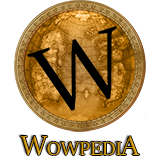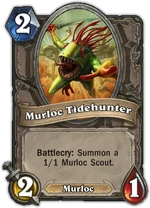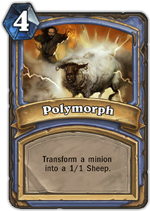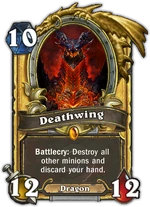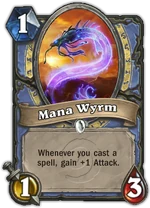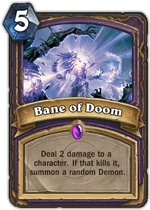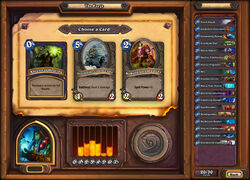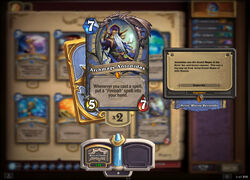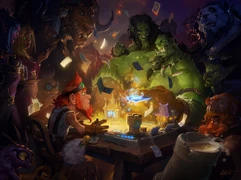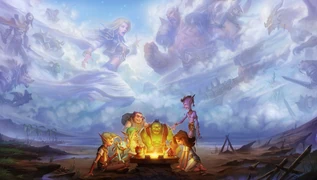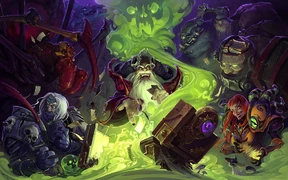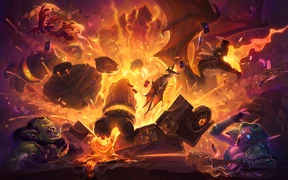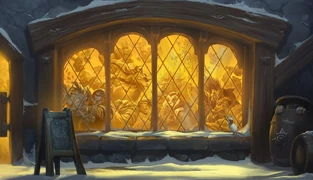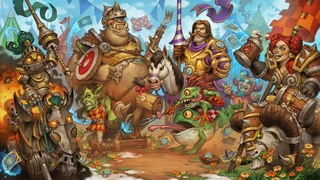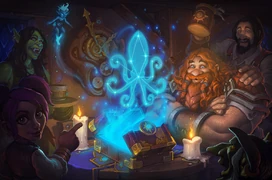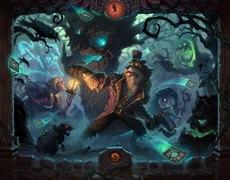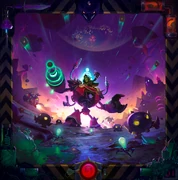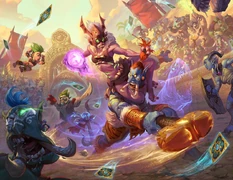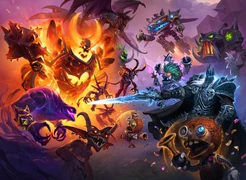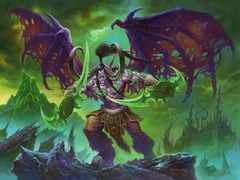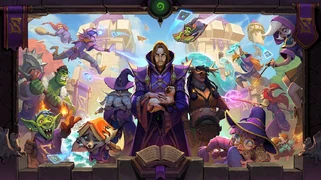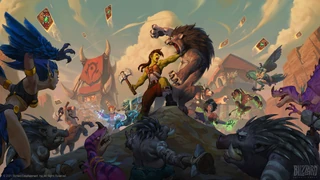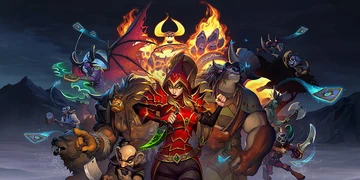| Hearthstone | |
|---|---|
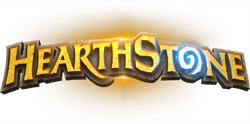 | |
| Developer(s) |
Blizzard Entertainment Team 5 |
| Publisher(s) | Blizzard Entertainment |
| Director(s) |
Ben Brode (formerly) Jason Chayes (formerly) Eric Dodds (formerly) |
| Designer(s) |
Derek Sakamoto Mike Donais |
| Composer(s) | Peter McConnell |
| Engine | Unity |
| Platforms | Microsoft Windows, macOS, Android, iPad, iPhone |
| Release |
Windows, macOS WW: March 11, 2014 iOS WW: April 16, 2014 Android WW: December 15, 2014 Amazon WW: December 17, 2014 |
| Genre(s) | Collectible card game |
| Mode(s) | Single player, multiplayer |
Hearthstone, originally subtitled Heroes of Warcraft,[1][2] is a free-to-play, digital card game set in the Warcraft universe. It was announced on 22 March 2013 at PAX East 2013,[3] and entered closed beta in the Americas region on 16 August 2013, and in the European region on 4 September 2013.[4] The game entered open beta worldwide on 21 January 2014,[5] and was fully released 11 March 2014.[6]
Hearthstone is available on Microsoft Windows and OS X operating systems, and on iPad, supporting iPad Air, iPad 4th generation, iPad 3rd generation, iPad 2, iPad mini, Android, iPhone and iPad mini with Retina display.[7] Hearthstone is planned to available for Windows 8 Touch and in the Windows 10 store.[8]
In Hearthstone, players can choose to play as one of nine legendary Warcraft heroes, taking turns to play cards from their customizable decks to cast potent spells, use heroic weapons or abilities, or summon powerful minions to crush their opponent.
Players can compete for glory and standing in the game's Ranked Play mode, battle legendary bosses from World of Warcraft's history in adventure mode, or forge a unique deck of randomly selected cards in the Arena, and can complete quests and earn prizes to gain gold and powerful new cards for their collection, constructing formidable decks with which to do battle. Hearthstone is designed to be a quick and accessible card game, that nonetheless features substantial strategic depth for more serious players.
Game details[]
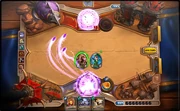
A game of Hearthstone in progress
Hearthstone is a collectible card game that revolves around turn-based online 1vs1 matches between two opponents, operated through Battle.net. Players can do battle as one of nine classes, with each offering its own strengths, powers and synergies, and can create their own custom decks from their card collections.
Players start the game with a substantial collection of 'basic' cards, but can gain rarer and more powerful cards through purchasing packs of additional cards, or as reward for competing in the Arena. Card packs and entry to the Arena can be purchased using real money, or gold, an in-game currency earned through completing special quests. Players can choose from a number of game modes, with each offering a slightly different experience.
Hearthstone is set within the Warcraft universe, with its characters, abilities and items drawing from existing lore. The game features detailed card art, much previously used for the World of Warcraft Trading Card Game, and uses infamous quotes and comical soundbites to bring to life many well-known characters from the franchise's history. Hearthstone also features colourful visuals and animated game boards, with interactive features to entertain players between rounds.
Matches[]
Each Hearthstone battle is a 1vs1 match between two opponents. Gameplay in Hearthstone is turn-based, with players taking turns to play cards from their hand, casting spells, equipping weapons, or summoning 'minions' to do battle on their behalf. Play may be between two human players, or one player and a computer-controlled opponent.
Each player is represented by their chosen 'hero', an important character from Warcraft lore. Each hero represents a particular class, determining the special cards and unique hero power available to them. Each hero has 30 Health - if that number is reduced to zero, the hero is destroyed, and the controlling player has lost the game. For a list of heroes and classes, see below.
At the start of each turn, the player draws a new card from their deck - a collection of 30 cards selected before battle. Players can choose to play using one of several pre-assembled 'basic' decks, or one of their own custom-made decks. While most cards are available to heroes of any class, a substantial portion are limited to a specific class, giving each hero their own strengths and unique possibilities.
During their turn, each player can choose to play any of their cards, use their hero power, command their minions to attack targets, or or attack directly using their hero, if they have a weapon equipped. However, which actions the player is able to take is partly determined by their mana. Each player starts the game with 0 mana crystals, but gains one at the start of each turn, until the maximum of 10 is reached. Each card and hero power requires the player to expend a specific amount of mana in order to play it, strategically limiting each player's actions. In addition, the larger mana pools in later rounds allow players to play increasingly expensive cards, opening the game up to ever more impressive moves and powerful abilities.
A match is concluded when one or both players has reached zero health, or chooses to concede. Completing a battle will grant each player's hero experience (with additional experience granted for winning) and can allow players to complete quests and earn gold. Winning games can also allow players to earn rewards in Arena and attain higher ranks in Ranked play.
Each match takes place on a randomly selected battlefield, representing the board on which the game is played. There are four possible battlefields: Stormwind, Orgrimmar, Pandaria and Stranglethorn. Each battlefield features its own design and numerous interactive elements, such as catapults that can be loaded and fired, bells that can be rung, windows and boxes that can be knocked at and broken, and lurking beasts that can be driven back into the shadows. However, these elements are purely for entertainment and in no way affect gameplay.
Classes and heroes[]
Players can choose from 10 classes, representing the classes from World of Warcraft. Each class is represented by a legendary figure from Warcraft's history.
Class determines which class-specific cards can be used, as well as granting a unique hero power - a special non-card ability which can be used once per turn for 2 mana. Through these mechanics, each class has its own powers, synergies and style. Unlike in World of Warcraft, it is not necessary to create a separate character in order to play as a new class - players can switch at will to a new class, using either a default basic deck or a custom deck of their own construction.
Each hero begins at level 1, and can be raised through earning experience to level 60 (matching the original level cap for World of Warcraft). Every two levels up to level 10 will reward players with a pair of new class-specific cards, similar to the learning of core abilities in World of Warcraft. Above level 10, reaching certain levels will grant golden versions of existing basic cards, a purely cosmetic reward which serves to display the player's progress to opponents in battle.
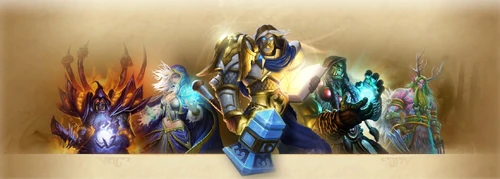
Heroes of Warcraft
Cards[]
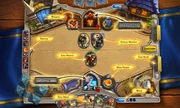
A guide to Hearthstone's user interface.
Cards are the main substance of Hearthstone, representing the abilities, characters and effects which each player is able to make use of during the match. There are currently 2,816 playable cards in the game, 2,187 of which can be collected, with more added each expansion.
Each player starts the game with a wide selection of 'basic' cards. Cards of higher rarity can be obtained by purchasing card packs, or as reward for success in the Arena. Card packs and entry to the Arena can be purchased using real money, or 'gold', an in-game currency earned through completing special 'quests', such as winning a certain number of matches, or dealing a certain amount of damage. Each card pack consists of five random cards, including at least one 'rare' card. Obtaining new cards allows the player to add them to their decks, opening up new possibilities for play and strategy.
Playing a card consumes mana equal to that card's mana cost, displayed in the top-left corner of each card.
Types[]
There are three main types of card: minions, spells and weapons.
Minions[]
Minion cards can be used to summon the described creature onto the battlefield, where they will fight for the player. Minion cards feature an Attack value, reflecting the damage that minion can deal in combat, a Health value, reflecting how much damage the minion can take before being destroyed. Minions are controlled by the player who summoned them, and can be commanded to attack their opponent's minions, or even the opposing hero. Minions with Taunt can act as tanks, preventing the opponent's forces from attacking the hero directly with melee attacks until that minion is destroyed. Minions are a major element in battles between heroes, and are usually responsible for the majority of all damage dealt in a game. Minions are the most common type of card.
Spells[]
Spell cards are cards that can be played to trigger a one time effect or ability, described in the card's text. In contrast to a minion or weapon card, a spell card will expire immediately after it has been used. Spells include many powerful and useful direct effects, such as damage and removal effects, minion buffs and hidden secret abilities. Spell cards do not have an Attack or Health value.
Weapons[]
Weapons are special cards which can be equipped by heroes. Each weapon has an Attack value and a Durability value. Each hero can only equip one weapon at a time, and equipping a new weapon will destroy the old one. Attacking using a weapon deals damage equal to its Attack, and reduces its Durability by 1. When a weapon's Durability is reduced to zero, the weapon will be destroyed. All classes except druids, priests and mages have some weapons available to them, with rogues, paladins and warriors generally considered to have the greatest synergy with weapons. Weapons are the least common type of card.
Decks[]
In all game modes except 'Arena', the player does battle using a deck of 30 cards, constructed from cards in the player's collection. Each deck can only feature two of each card, and only one of each 'legendary' card. Arena play features no such limitations, but requires players to play using a new deck chosen from a series of randomly provided selections. For either type of deck, the construction of a player's deck is a key strategic element in the game, determining which cards are available to them during the course of a match. Each deck is also limited by its chosen class, with class-specific cards only available in decks of the same class.
Players are provided with a basic deck for each class, and can create their own custom decks through the collection manager.
Card set and rarity[]
In addition to type, cards are divided in two primary ways: card set and rarity.
Card set deals with how a card is obtained. Basic cards are available freely to all players, either being included in their collections from the start of the game, or gained through raising the appropriate class to level 10, while expert cards are obtained through card packs or as Arena rewards. The other card sets, reward and promotions, include a small number of cards available through completing special quests, or in relation to real-world promotions. While basic cards form the foundation for any deck, the most powerful and outlandish cards belong to the expert and other sets.
Rarity refers to a card's overall quality and scarcity. Hearthstone uses a rarity color-scheme similar to that of World of Warcraft, with the exception that there is no 'uncommon' rarity. The rarities and matching colors are therefore free, common, rare, epic and legendary. However, unlike in World of Warcraft, rarity does not directly affect the strength of a card through means such as item level. Rather, rarity tends to roughly illustrate some degree of increased power or utility. A common expert minion will usually bring higher stats or more powerful abilities than a basic minion of the same mana cost, but lower stats or less utility than the equivalent rare or epic minion. Fittingly, legendary cards are especially notable, depicting key characters from Warcraft lore, and typically bring extraordinary powers to the game, such as sourcing new cards directly from the Emerald Dream, or manipulating the very sands of time.
Nonetheless, while higher rarity cards offer an overall advantage over lower rarity equivalents, Hearthstone's tactical nature generally prevents players from winning by rarity of cards alone. While a well-timed star appearance can be enough to tip the scales in the player's favor, not every legendary is considered a strong card, and even Deathwing himself is quite capable of being beaten by a free or common card under the right circumstances.
Crafting and disenchanting[]
Players can also use the crafting system to create new cards. The system uses 'arcane dust' to craft specific cards. Arcane dust can be obtained as an Arena reward, or by destroying existing cards, allowing players to convert unwanted cards into more desirable options. The crafting system was created as an alternative to the player card trading prevalent in trading card games such as Magic: The Gathering, removing the risk, uncertainty and imbalance found in the trading of cards between players, and providing players with a reliable and direct means of obtaining specific cards, which nonetheless allows players to trade-in their unwanted cards for more desirable alternatives. There are no plans to introduce card-trading between players.
Golden cards[]
Similar to the 'foils' found in physical collectible card games, Hearthstone features 'golden' cards, special versions of regular cards featuring a golden border and unique animations. These cards are far harder to obtain than their regular versions, and cost more arcane dust to craft. Golden cards differ from their regular counterparts purely cosmetically, and are designed to allow players to show off their accomplishments. Golden basic cards can be obtained by levelling heroes, while golden versions of cards from other sets must be crafted or gained from card packs or rewards.
Acquiring cards[]
New cards can be earned in several ways. Players begin the game with a substantial collection of basic cards, and can earn further basic class cards through raising each hero to level 10. To collect expert cards, players can either spend gold or real money to purchase card packs directly, or may win packs or individual cards as reward for competing in the Arena. Card packs are packs of 5 random cards, guaranteed to contain at least 1 rare or higher rarity card. Some cards can also be acquired through completing special quests, such as by collecting all murloc minions.
Game modes[]
Four main game modes are available to play in Hearthstone, with each offering a slightly different set of rules, and its own rewards.
Single-player[]
Tutorial[]
The game features a Tutorial, a limited and non-repeatable starting experience designed to introduce players to Hearthstone, in which the player is pitched against a series of special opponents, with substantial dialogue elements.
Adventure mode[]
Adventure mode refers to the entire single-player experience provided by Hearthstone, consisting of the three game modes: Practice mode, Adventures, and Missions.
Practice mode[]
Practice mode allows players to do battle against a selection of computer opponents. Players can choose which class to play against, as well as one of two difficulty settings: basic and expert. Each opponent and difficulty setting features its own deck.
Basic opponents offer players a chance to learn the basics of the game, explore a new class, or prepare for battle in Play mode, and use decks comprising only basic cards. Expert opponents offer a stiffer challenge, giving players the chance to try their hand against decks featuring higher rarity cards and specific plays.
Players can unlock and level heroes in Practice mode, making it the ideal mode for exploring a new class and acquiring its basic cards. The choice of opponent also allows players to focus on problem classes.
Adventures[]
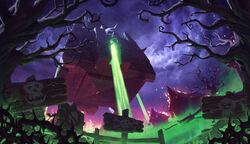
The floating necropolis of Naxxramas in the Curse of Naxxramas trailer
Adventures are non-free single-player PvE game modes, revolving around special boss encounters. Each adventure has a theme, and brings around a small new collectable card set to the game, including neutral and class-specific cards.
Adventures feature a selection of battles against computer-controlled bosses, each representing a well-known adversary from Warcraft lore. Each boss presents a unique encounter, featuring special hero powers and decks. Bosses uses a combination of regular cards and boss cards, special and often extremely powerful cards not available to players. Bosses can be encountered in Normal or Heroic mode, and defeating a Heroic boss usually presents quite a challenge, with players needing to devise special decks to counter the mechanics of that specific fight.
Adventures also feature Class Challenges, special class-specific versions of existing boss battles using specific prepared decks.
Adventures offer rewards in the form of new cards to use in the rest of play, as well as a new card for defeating all bosses in Heroic mode.
Missions[]
Missions refer to the free single-player adventure game modes.
Multiplayer[]
Play mode[]
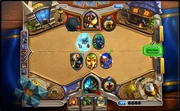
A game of Hearthstone in progress.
Play mode matches players against other human players of similar skill, in random matches. Players can choose to play Casual 'friendly' games, or take part in Ranked play, earning ranks and special rewards to reflect their skill and standing within the community.
Ranked play features a 26-tier rank system, with wins allowing the player to progress to higher ranks, and losses causing them to descend in rank. All ranks are subject to a soft-reset at the end of each season, with each season lasting for one month. Ranked play also provides special cosmetic rewards, including alternate card back designs and animated golden hero portraits.
Arena[]
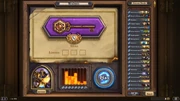
Commencing an Arena run.
The Arena offers a unique challenge, with players forging a new deck from a random selection of cards before using it to do battle in a series of games. A successful run in Arena can offer substantial rewards, including gold, Arcane Dust and card packs, but can be costly and difficult to achieve. Access to the Arena is purchased with gold or real money.
Unlike other game modes, the Arena does not use a pre-made deck, but one that is assembled at the start of that Arena run. Upon entering the Arena the player is given a random selection of 3 classes to choose one. Once a class has been chosen, the player is provided with 30 selections of 3 possible cards, choosing one - and only one - from each selection, slowly building a full deck. Unlike other decks, which are limited to 2 of each card, decks made in Arena may feature any number of the same card. As in any game mode, the strength of the deck constructed is a large part of achieving victory, but Arena's randomised process offers players an additional challenge in anticipating the cards on offer.
Once a deck is constructed, the player is placed in a series of matched games using that deck, although the games do not have to be played all at once. Once the player has won 12 games, or lost 3, the Arena run is ended, and the player is offered a reward determined by their accomplishments that run. Players who do well can reap handsome rewards, but failing to achieve a good run can turn the Arena into an expensive gamble.
Battlegrounds[]
Battlegrounds is a game mode where eight players face off in 1v1 rounds, with the goal to be the last player standing. Each round consists of two phases. The Recruit Phase lets players can purchase and sell minions, upgrade the tavern, use their hero power, and rearrange their minions' attack order. Combat Phase has minions automatically attacking the opponents' until one player (or both) has no minions remaining, at which point the victor attacks the loser directly.
Unlike other play modes, Battlegrounds has a set of cards totally unique to itself (although many are functionally identical to collectible cards) as well as a pool of specialized heroes. All Battlegrounds cards are available from the beginning.
Battlegrounds is significantly different from all other play modes in Hearthstone, featuring completely different mechanics from anything previously seen. There is no mana: instead, the only currency is Coins (similar to the Bartender Bob, Bartendotron, and Bazaar Bob encounters from previous Single-player adventures). All minions cost 3 coins, with the power of minions instead dictated by their Tavern Tier, taking the usual place of mana on the card interface. Minions do not attack the opponent directly - rather, surviving minions add Tavern Tier to the hero's attack once the round is over.
Duels[]
Duels is a game mode where players face off against other players, attempting to claim 12 victories before they suffer 3 losses, similar to Arena. However, instead of drafting a deck, players are offered a choice between 4 of Hearthstone's 10 classes, then one of three of special class Hero Powers, followed by one of six of that class's Signature Treasures. Players then must build a 16-card deck, using 15 cards from their collection, and the treasure they selected.
At the end of each round, whether it was a win or a loss, the player gains 5 higher maximum health and chooses three cards to add to their deck from three separate choices, similar to Dungeon Run and other single-player missions. Occasionally, the player can also pick a passive or active treasure to add to their deck.
Tavern Brawl[]
Tavern Brawls is a "For Fun" game mode, offering a wide array of rules and changes every week. Tavern Brawls are available between Wednesdays to Sundays (in the Americas). Tavern Brawls are unlocked for players who have reached level 20 on at least one hero. The first win of the Tavern Brawl week grants a free Classic Card Pack as well.
Each Tavern Brawl presents a limited time opportunity to face other players in special matches with unique rules. These might be requiring players to use special pre-made decks, adding random cards or minions, or changing the very rules of ability activation or mana use. Some Tavern Brawls allow the player to construct special decks especially for the challenge from within the game mode itself, while others provide powerful premade decks, or entirely random decks, and some Brawls even see players take control of special heroes with their own Hero Powers or contain co-op or single-player encounters. Some Brawls feature Tavern Brawl cards, special cards not available in other types of play, as well as boss cards from adventures. Each week sees a fresh Tavern Brawl, with its own unique rules.
Friendly Challenge[]
A duel players challenge players to on their friends' list to unranked matches. Duels offer no rewards, save the satisfaction of crushing your friends in combat.
Expansions and other game additions[]
Each year, Hearthstone receives three expansions, which add new cards available through card packs and crafting. Each expansion has its own setting and theme and generally introduces unique mechanics or new card abilities based on said theme. Between the game's release in 2014 and the start of the Year of the Mammoth in spring 2017, Hearthstone content releases alternated between expansions and PvE adventures. Starting in 2017, no standalone adventures are released and each expansion instead features optional adventure-style content that mainly serves to illustrate the expansion's story and characters. Beginning at the end of 2020, expansions are also accompanied by a mini-set released a few months later, which mix and match together themes from the rest of the year.
| Title | Type | Release date | Setting | Major themes | |
|---|---|---|---|---|---|
| Curse of Naxxramas | Adventure | July 22, 2014 | Naxxramas | Deathrattle | |
| Goblins vs Gnomes | Expansion 1 | December 8-10, 2014 | None | Mechs, Spare Parts, randomness | |
| Blackrock Mountain | Adventure | April 2-3, 2015 | Blackrock Mountain | Dragons | |
| Tavern Brawl | Game mode | June 17, 2015 | Various | Special matches with unique rules that change every week | |
| The Grand Tournament | Expansion 2 | August 24, 2015 | Argent Tournament Grounds | Hero Powers, Inspire, Joust | |
| The League of Explorers | Adventure | November 12-13, 2015 | Various | Discover | |
| Year of the Kraken | |||||
| Whispers of the Old Gods | Expansion 3 | April 26-27, 2016 | None | Old Gods, C'Thun cultists, corrupted versions of old cards, forbidden spells | |
| One Night in Karazhan | Adventure | August 11, 2016 | Karazhan | Spell synergy, minion summoning, portals | |
| Mean Streets of Gadgetzan | Expansion 4 | December 1-2, 2016 | Gadgetzan | Grimy Goons, Jade Lotus, and Kabal crime families with their own themes and tri-class cards | |
| Year of the Mammoth | |||||
| Journey to Un'Goro | Expansion 5 | April 6-7, 2017 | Un'Goro Crater | Dinosaurs, Elementals, Adapt, Quests | |
| Knights of the Frozen Throne | Expansion 6 and missions | August 10-11, 2017 | Icecrown Citadel | Death knight-themed hero cards, Deathrattle, Lifesteal | |
| Kobolds & Catacombs | Expansion 7 | December 7-8, 2017 | The Catacombs | Legendary weapons, Recruit, Spellstones | |
| Dungeon Run | Missions | ||||
| Year of the Raven | |||||
| The Witchwood | Expansion 8 | April 12, 2018 | Gilneas; Blackwald | Echo, Rush, odd and even-Cost cards, transforming human/worgen minions | |
| Monster Hunt | Missions | April 26, 2018 | |||
| The Boomsday Project | Expansion 9 | August 7, 2018 | Netherstorm | Mechs, Magnetic, Legendary spells | |
| Puzzle Lab | Missions | August 21, 2018 | |||
| Rastakhan's Rumble | Expansion 10 | December 4, 2018 | Gurubashi Arena | Loa, Spirits, Overkill | |
| Rumble Run | Missions | December 13, 2018 | |||
| Year of the Dragon | |||||
| Rise of Shadows | Expansion 11 | April 9, 2019 | Dalaran | Lackeys, Twinspell, callbacks to previous expansion mechanics | |
| The Dalaran Heist | Missions | May 16, 2019 | |||
| Saviors of Uldum | Expansion 12 | August 6, 2019 | Uldum | Reborn, Quests, Plague spells | |
| Tombs of Terror | Missions | September 17, 2019 | |||
| Battlegrounds | Game mode | November 12, 2019 | Bob's Tavern | 8 players face off in 1v1 rounds. Warbands are improved between rounds and minions automatically attack during combat. | |
| Descent of Dragons | Expansion 13 | December 10, 2019 | Dragonblight | Galakrond, Invoke, Dragons in general, Sidequests | |
| Galakrond's Awakening | Adventure | January 21, 2020 | Dragonblight; Dalaran | Celebrates all keywords and mechanics introduced during the previous 3 expansions | |
| Demon Hunter Prologue | Missions | April 2, 2020 | Ancient Kalimdor | Demon Hunter class and Demon Hunter Initiate special card set reward cards unlocked on April 7, 2020 | |
| Year of the Phoenix | |||||
| Ashes of Outland | Expansion 14 | April 7, 2020 | Outland | Demon Hunter, Dormant, Prime Legendaries | |
| Trial by Felfire | Missions | June 17, 2020 | |||
| Scholomance Academy | Expansion 15 | August 6, 2020 | Scholomance | Spellburst, Dual-class cards, Soul Fragments, Studies | |
| Book of Heroes | Missions | September 15, 2020 (first release) | Various | Stories of the heroes who represent the 10 classes in Hearthstone | |
| Madness at the Darkmoon Faire | Expansion 16 | November 17, 2020 | Darkmoon Island | Corrupt, Vendors, return of the Old Gods | |
| Duels | Game mode | Various | Players build decks using powerful treasure cards and become stronger after every match. Decks last until 12 wins or 3 losses | ||
| Darkmoon Races | Mini-set | January 21, 2021 | Darkmoon Races | Celebrates all keywords and mechanics introduced during the previous 3 expansions | |
| Year of the Gryphon | |||||
| Forged in the Barrens | Expansion 17 | March 30, 2021 | The Barrens | Frenzy, Ranked spells, Spell schools, Mercenaries, The Horde | |
| Book of Mercenaries | Missions | April 6, 2021 (first release) | Various | Stories of the 10 new mercenary characters | |
| Wailing Caverns | Mini-set | June 3, 2021 | Wailing Caverns | Dungeoneers, Adventurers | |
| United in Stormwind | Expansion 18 | August 3, 2021 | Stormwind City | Tradeable, Questlines, Mounts, Profession Tools, The Alliance | |
| Mercenaries | Game mode | October 12, 2021 | Various | Strategic RPG gameplay and roguelike missions | |
| Deadmines | Mini-set | November 2, 2021 | Deadmines | Pirates, Parrots | |
| Fractured in Alterac Valley | Expansion 19 | December 7, 2021 | Alterac Valley | Honorable Kill, Hero cards, Objectives, the rivalry between Horde and Alliance | |
| Onyxia's Lair | Mini-set | February 15, 2022 | Onyxia's Lair | Dragons | |
| Year of the Hydra | |||||
| Voyage to the Sunken City | Expansion 20 | April 12, 2022 | Zin-Azshari | Naga, Dredge, Colossal, shuffling cards into the deck | |
| Throne of the Tides | Mini-set | June 1, 2022 | Throne of the Tides | Ozumat vs. Neptulon | |
| Murder at Castle Nathria | Expansion 21 | August 2, 2022 | Castle Nathria | Locations, Infuse, investigation | |
| Maw and Disorder | Mini-set | September 27, 2022 | The Maw | Accusations, advanced Infuse, Sylvanas on trial by the Jailer | |
| Path of Arthas | Missions | December 6, 2022 | Lordaeron; Northrend | Introductory Death Knight class cards | |
| March of the Lich King | Expansion 22 | December 6, 2022 | Silvermoon City | Manathirst, Blood elves, Undead | |
| Return to Naxxramas | Mini-set | February 14, 2023 | Naxxramas | Callbacks to Curse of Naxxramas | |
| Year of the Wolf | |||||
| Festival of Legends | Expansion 23 | April 11, 2023 | Thousand Needles | Legendary musicians and songs, instruments, solo artists, Finale, Overheal | |
| Audiopocalypse | Mini-set | May 31, 2023 | Dual-class cards, remixes | ||
Lore[]
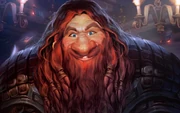
Harth Stonebrew, the innkeeper.
The canonicity of the game of Hearthstone is that of flavor lore. It is a card game developed and played at inns around Azeroth and Draenor,[9] as can be seen in World of Warcraft, but as such may not accurately represent things as they really are.[10]
More specifically, the game mainly takes place in a special inn, owned by the dwarven innkeeper Harth Stonebrew, whose visitors claim that it appeared to them when they most needed it in locations as wildly different as Orgrimmar to the Swamp of Sorrows.[9]
Though Hearthstone mostly draws from already existing Warcraft lore, it has also introduced many new concepts, characters, and even races not seen in previously established canon material, such as Skycap'n Kragg, Elise Starseeker, energy-camels, and tortollans, moreso in recent expansions and adventures. Whether or not these Hearthstone-specific characters actually exist within the canon Warcraft universe has not yet been determined.[11] Some elements and characters (such as Skycap'n Kragg and the tortollans) have since made the transition into World of Warcraft, making them canon, though elements of them often differ from their original Hearthstone depictions. For a comprehensive list of Hearthstone-specific characters, see "Original cards in Hearthstone" on the Hearthstone wiki.
In-universe, Hearthstone is played in several locations, such as the Shrine of Two Moons and Shrine of Seven Stars in the Vale of Eternal Blossoms, Flayers' Point in Desolace,[12] the Guardian's Study in Karazhan, Greywatch in Stormheim, the Lowtide Tavern in Drustvar, Deadwash in Stormsong Valley, an unnamed inn in Freehold in Tiragarde Sound, the Missing Hinge Inn in the Azure Span and the Algeth'ar Academy. Several characters, such as Railmaster Rocketspark, Yumadormu and The Great Akazamzarak, own Hearthstone cards, and the gorilla Winstone is a champion Hearthstone player. Hearthstone as an in-universe game may be older than previously assumed, as it is tradition in Guo-Hee Calmwater's family to pass card collections from parent to firstborn. A drakonid ghost used to collect cards before their death millennia ago,[13] but it seems their own variant of the game had some differences with the modern one.[14]
For more information, see "Hearthstone lore" on the Hearthstone wiki.
- Hearthstone characters that appear in World of Warcraft

 Morgl the Oracle
Morgl the Oracle 

 Sir Finley Mrrgglton
Sir Finley Mrrgglton 

 Elise Starseeker
Elise Starseeker 

 Reno Jackson
Reno Jackson 

 Skycap'n Kragg
Skycap'n Kragg 

 Sarge
Sarge  (as a mount)
(as a mount)
 A. F. Kay
A. F. Kay 

 Cariel Roame
Cariel Roame 
Notes and trivia[]
- The game was also released for iPad, iPhone, Android and Windows 8 Touch versions over the course of 2014.
- Carbot Animations made cartoon-styled parodies of Hearthstone called HurtStone.
- A zone named Hearthstone Tavern was planned for patch 8.2.5.
- The art style of Hearthstone diverges from that of the mainline Warcraft games, but are still meant to be the same elements, just represented differently. For instance, rounder shapes are used to make Hearthstone characters look "cuter." In body design, this can be seen in rounder eyes and foreheads, so while a Hearthstone orc is perhaps 90-95% the same creature as a Warcraft orc, the Hearthstone visual style puts emphasis on different elements.[15]
Crossover and references[]
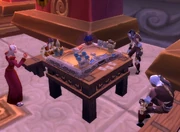
Horde NPCs enjoying a game of Hearthstone
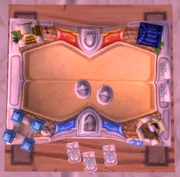
The in-game board from above; compare actual Hearthstone screenshots
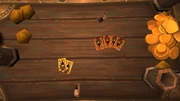
Hearthstone cards.
From the game's very first announcement, there has been talk of cross-play between Hearthstone and World of Warcraft. During the game's alpha test the developers were already discussing the possibility of allowing players to play Hearthstone from within World of Warcraft.[16] However, no solid plans have yet been announced.
One possible avenue for the eventual introduction of cross-play came with patch 5.4.0, when two full-sized Hearthstone boards were added to each faction's shrine in the Vale of Eternal Blossoms. These detailed, three-dimensional sets come with cards, mana crystals and even a tiny gryphon on the Stormwind map used by the models. NPCs can be found playing the game from nearby benches and spectating, apparently discussing the game in progress and occasionally cheering the players on. No moving parts are involved, although every so often a small ![]() [Arcane Explosion] occurs above the game board. Players are free to sit on the benches around unoccupied boards, with some roleplayers including games of Hearthstone in their WoW characters' activities. Some have even begun taking their WoW characters over to Hearthstone for some in-character fun with their roleplaying friends and guildmates.[17][18]
[Arcane Explosion] occurs above the game board. Players are free to sit on the benches around unoccupied boards, with some roleplayers including games of Hearthstone in their WoW characters' activities. Some have even begun taking their WoW characters over to Hearthstone for some in-character fun with their roleplaying friends and guildmates.[17][18]
To mark the release of Hearthstone, on 11 March 2014 the ![]() [Hearthsteed] mount was made available to World of Warcraft players as a reward for winning three games in Hearthstone's Play or Arena modes. As a free to play game, this served to encourage WoW players to try Hearthstone, and marked the first significant and rewarding crossover between the two games.
[Hearthsteed] mount was made available to World of Warcraft players as a reward for winning three games in Hearthstone's Play or Arena modes. As a free to play game, this served to encourage WoW players to try Hearthstone, and marked the first significant and rewarding crossover between the two games.
The developers have discussed the possibility of adding further crossover in the future, such as Hearthstone card packs dropping from WoW bosses.
With patch 6.0.2, two new toys related with Hearthstone were released (![]() [Hearthstone Board] and
[Hearthstone Board] and ![]() [Winning Hand]). Also, a garrison quest related to Hearthstone was added where the follower have to face 3 famous decks (Zoolock, Miracle Rogue and Control Warrior). The awards are the
[Winning Hand]). Also, a garrison quest related to Hearthstone was added where the follower have to face 3 famous decks (Zoolock, Miracle Rogue and Control Warrior). The awards are the ![]() [Hearthstone Strategy Guide] (that teaches a follower the Hearthstone Pro trait) and
[Hearthstone Strategy Guide] (that teaches a follower the Hearthstone Pro trait) and ![]() [Autographed Hearthstone Card] (a toy with references to famous players of Hearthstone). During the Rocketspark and Borka encounter in Grimrail Depot, players can force Borka the Brute to destroy several of Railmaster Rocketspark's possessions, including his entire collection of Hearthstone cards.
[Autographed Hearthstone Card] (a toy with references to famous players of Hearthstone). During the Rocketspark and Borka encounter in Grimrail Depot, players can force Borka the Brute to destroy several of Railmaster Rocketspark's possessions, including his entire collection of Hearthstone cards.
On the 14th of March 2016, it was announced on the official Hearthstone website that Lady Liadrin, the new alternate hero (player character) for the paladin class, would be obtained through a special World of Warcraft promotion. Rather than being purchased with real money like the previously released alternate heroes, to obtain Liadrin one must level at least one World of Warcraft character to level 20 and earn the ![]() [Fledgling Hero of Warcraft] achievement.[19]
[Fledgling Hero of Warcraft] achievement.[19]
In World of Warcraft: Legion, players can find a ![]() [Golden Hearthstone Card: Lord Jaraxxus] in the Nighthold, and the Great Akazamzarak is the owner of a golden Dr. Boom card. Discarded Hearthstone cards are picked up from the Legerdemain Lounge for the Inscription quest
[Golden Hearthstone Card: Lord Jaraxxus] in the Nighthold, and the Great Akazamzarak is the owner of a golden Dr. Boom card. Discarded Hearthstone cards are picked up from the Legerdemain Lounge for the Inscription quest ![]() [50 Daily] Clues Abound, while in Battle for Azeroth, a pair of Hearthstone Enthusiasts can be found at Anyport in Drustvar. Different Hearthstone cards can also be found on Mechagon Island.
[50 Daily] Clues Abound, while in Battle for Azeroth, a pair of Hearthstone Enthusiasts can be found at Anyport in Drustvar. Different Hearthstone cards can also be found on Mechagon Island.
Development[]
Early development[]
Hearthstone was developed by Team 5, which was formed in 2008. The desire was to create a game in a genre Blizzard had not designed for before, in this case, a card game. It was decided early in development that the game would be based on the Warcraft universe, borrowing creatures, powers, and heroes from the franchise. In this early stage of development, Chris Metzen and Mike Morhaime were enthusiastic about the project, but doubts existed within Blizzard.[20] Additionally, it has been stated that the development of Hearthstone began as an attempt to recapture elements of the Warcraft RTS games, namely the tongue-in-cheek moments. As World of Warcraft shifted to epic-scale events, Hearthstone was seen as an opportunity to bring back some of the early games' irreverence. It was decided that the game would be based around cards rather than pieces, in order to differentiate Hearthstone from the RTS games.[21]
The development knew they would be walking a line between remaining faithful to the Warcraft visual style, while also giving the game its own identity. During the game's inception phase, four design pillars were established:
- Charming and Whimsical (the game is allowed to be epic, but must remain charming)
- Simple and Clean (the game must be immediately recognizable, readable, approachable, and not require a lot of communication from a visual standpoint as to what's occurring)
- Real and Physical (the cards must convey its physicality; the idea that an actual card game is being played)
- A Valuable Collectible (the cards can be embelished, as due to being a digital game, physical costs aren't an issue)[22]
By this point, Hearthstone was still an unnamed game, and many in Blizzard weren't sold on the game. A point of contention was the fact that the game wouldn't focus on a Horde vs. Alliance scenario, which was considered integral to the Warcraft IP. To sell the idea, a piece of art was illustrated by Laurel Austin, showing Horde and Alliance characters in the same room and having fun. The idea was that Hearthstone could show the two factions getting along. The artwork proved integral in getting staff to warm up to the concept.[23]
When it came to choosing the game's title, an open call was put out to all Blizzard employees to suggest a name. "Hearthstone" was one of the suggestions, and it was a name that the developers kept coming back to, and eventually settled upon. Harth Stonebrew was designed to be the "face" of the game.[24]
A lot of time was spent on "paper design," where the developers nailed down ideas while Team 5's engineers were temporarily transferred to work on World of Warcraft. Physical cards were designed in this period as per the lack of engineers. A flash prototype was also created. In terms of mechanics, this version was practically identical to the final version, though lacked the artistic style. The engineers used this version as the basis for the final version in terms of mechanics.[25]
Versions of the game were rolled out for internal play within Blizzard layer by layer, steadily giving more and more people access to the game. By December 2012 Hearthstone had gained broad exposure within Blizzard, and there was more confidence in the project.[20] Prior to the summer of 2013, members of Team 4 had been transferred to work on the game.[26]
Later development[]
In August 2013 the game entered closed beta,[20] with full release eventually coming in March 2014. As of October 2014, over 20 million people have played the game. It had the internal effect of getting Blizzard to look at the potential for other platforms.[27] As of February 2018 however, the game has not been ported to any console, and there are no plans to release it on the Nintendo Switch.[28]
A conceptual shift occurred in 2014, with the release of the Goblins vs. Gnomes expansion. Cinematics Director Jeremiah Johnson started singing and dancing the lyrics that would appear in the expansion's trailer. This set the stage for future trailers which would feature lyrics to sell the theme. As time went on, Hearthstone began asking "What if?" in regards to the Warcraft setting. One Night in Karazhan is an example of this philosophy, the question of "What if (Medivh held a party in Karazhan when he was young, before it became haunted)?"[29]
As of April 2017, the game has 70 million registered users.[30]
Awards[]
- Main article: Blizzard Entertainment
Gallery[]
Year of the Kraken, the first year of standard format.
Videos[]
Press information[]
- Alpha Press Release (2013-03-22)
See also[]
- This section contains items that is within the World of Warcraft but relates to the card game, Hearthstone.
 [Hearthsteed]
[Hearthsteed] [Autographed Hearthstone Card]
[Autographed Hearthstone Card] [Hearthstone Strategy Guide]
[Hearthstone Strategy Guide] [Hearthstone Board]
[Hearthstone Board] [Pack of Hearthstone Cards]
[Pack of Hearthstone Cards] [Winning Hand]
[Winning Hand] [Rotting Deck]
[Rotting Deck]
References[]
- ^ Alex Ziebart 2016-11-21. Blizzard Watch: Hearthstone no longer Heroes of Warcraft. Blizzard Watch.
- ^ JR Cook 2016-11-20. BlizzPro: Hearthstone Removing Heroes of Warcraft Subtitle. BlizzPro.
- ^ http://us.blizzard.com/en-us/news/?d=2013-3#220819
- ^ http://www.wowhead.com/news=218273/hearthstone-closed-beta-now-live-wowheads-hearthstone-database-and-tooltips
- ^ http://www.wowhead.com/news=227064/hearthstone-open-beta-is-here
- ^ Welcome to the Hearthstone Launch!
- ^ Zeriyah 2014-04-16. Hearthstone™ Now Available on iPad®!. Blizzard Entertainment.
- ^ Medievaldragon 2014-11-04. Activision Blizzard Q3 2014 Conference Call – Transcript. BlizzPlanet. Retrieved on 2014-11-05.
- ^ a b The Innkeeper's Tale
- ^ Muffinus on Twitter (2015-07-04). “HS is a game played in WoW's inns, thus HS's things exist, but may not be "real" per se. Like you buying a Transformers toy.”
- ^ Micky Neilson on Twitter: Are creatures that appeared only in HS part of the lore?(lightspawn,mechs from GvG,mounts from GT) "Undetermined, as far as I know."
- ^ World of Warcraft: Traveler, chapter 5
- ^
 [65-68] The Heart of the Deck
[65-68] The Heart of the Deck
- ^ Legendary Foil#Completion
- ^ Forging Worlds: Stories Behind the Art of Blizzard Entertainment, p.g. 73
- ^ World of Warcraft's Hearthstone could include cross-play, be playable inside WoW. Polygon.com (2013-03-22). Retrieved on 2014-04-01.
- ^ Official Forums - (A-RP)An In-Character Club for Hearthstone Players (2014-03-13)
- ^ Official Forums - Grand AD Hearthstone Tournament (29th March 7PM) (2014-03-16)
- ^
 Avarius 2016-03-14. A New Hearthstone Hero Has Come to Light!. Retrieved on 2016-03-15.
Avarius 2016-03-14. A New Hearthstone Hero Has Come to Light!. Retrieved on 2016-03-15.
- ^ a b c Hearthstone™ Closed Beta Test Begins! (2013-08-16).
- ^ Forging Worlds: Stories Behind the Art of Blizzard Entertainment, p.g. 68
- ^ Forging Worlds: Stories Behind the Art of Blizzard Entertainment, p.g. 70, 71
- ^ Forging Worlds: Stories Behind the Art of Blizzard Entertainment, p.g. 72
- ^ Forging Worlds: Stories Behind the Art of Blizzard Entertainment, p.g. 76
- ^ 2014, Hearthstone: 10 Bits of Design. GDC Vault, retrieved on 2015-09-05
- ^ 2015-05-27, BlizzCon 2014 – Overwatch Origins Panel Transcript. Blizzplanet, retrieved on 2015-05-31
- ^ Phillip Kolar. The Three Lives of Blizzard Entertainment. Polygon. Retrieved on 2014-10-04.
- ^ No Hearthstone on Switch, Confirms Blizzard. IGN (2018-02-12). Retrieved on 2018-02-13.
- ^ Forging Worlds: Stories Behind the Art of Blizzard ENtertainment, p.g. 78, 79
- ^ Hearthstone Celebrates 70 Million Players. Blizzplanet (2017-05-02). Retrieved on 2017-05-05.
External links[]
| |||||||||||||||||||||||||||||||||||||||||||||||||||||||
| |||||||||||||||||||||||||||||||

